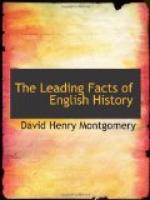A few years later, the Norman Conqueror built the Abbey of Battle on the spot to commemorate the victory by which he gained his crown. He directed that the monks of the abbey should chant perpetual prayers over the Norman soldiers who had fallen there. Here, also, tradition represents him as having buried Harold’s body, just after the fight, under a heap of stones by the seashore. Some months later, it is said that the friends of the English King removed the remains to Waltham, near London, and buried them in the church which he had built and endowed there. Be that as it may, his grave, wherever it is, is the grave of the old England. Henceforth a new people (though not a new race, for the Normans originally came from the same Germanic stock as the English did) (S62) will appear in the history of the island.
Several contemporary accounts of the battle exist by both French and English writers, but one of the best histories of it is that which was wrought in colors by a woman’s hand. It represents the scenes of the famous contest on a strip of canvas known as the Bayeux Tapestry (S155), a name derived from the French town where it is still preserved.
76. Close of the Period; what the Saxon Conquest of Britain had accomplished.
The death of King Harold ends the Saxon or English period of history. Before entering upon the reign of William the Conqueror let us consider what that period had accomplished. We have seen that the Jutes, Saxons, and Angles (SS36, 37) invaded Britain at a critical period. Its original inhabitants had become cowed and enervated by the despotism and the worn-out civilization forced on them by the Romans (SS30-32).
The newcomers brought that healthy spirit of barbarism, that irrepressible love of personal liberty, which the country sorely needed. The conquerors were rough, ignorant, cruel; but they were vigorous, fearless, and determined.
These qualities were worth a thousand times more to Britain than the gilded corruption of Rome. But in the course of time the Saxons or English themselves lost spirit (S36). Their besetting sin was a stolidity which degenerated into animalism and sluggish content.
77. Fresh Elements contributed by the Danes or Northmen.
Then came the Danes or Northmen (SS52, 63). They brought with them a new spirit of still more savage independence which found expression in their song, “I trust my sword, I trust my steed, but most I trust myself at need.”
They conquered a large part of the island, and in conquering regenerated it. So strong was their love of independence, that even the lowest classes of farm laborers were quite generally free.
More small independent landholders were found amongh the Danish population than anywhere else; and it is said that the number now existing in the region which they settled in the northeast of England is still much larger than in the south. (See map facing p. 32.) Finally, the Danes and the English, both of whome sprang from the North Germanic tribes (S36), mingled and becames in all respects one people.




